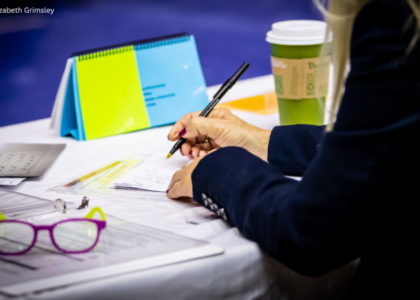With NCAA season right around the corner, it’s time for us to review some of the most popular skills in NCAA, and how they are evaluated. For this article, I picked skills that I thought were both popular, but also more complicated in evaluating. You won’t see basic core skills like kips, cast to handstands, or back handspring layout series on beam. Instead, I focused on some of the other skills that have more to them than just performing them with good form. Below you’ll find examples of about three elements or combinations on each event that I’ve broken down what exactly the judges are looking for in a well-executed routine. After reading this article and mastering the evaluation of the skills here, you’ll be ready to comment and critique right alongside your favorite NCAA commentators.
A HUGE change this year is the addition of a new “hold deduction,” which was added to the NCAA Modifications this year. The WGCA provided further guidance on applying this deduction, which was published in the November 1st NCAA Women’s Gymnastics Newsletter:
The gymnast must show a controlled finish position (legs straight, arms up) for 1 second at the completion of the routine. This position must be held facing the direction in which they landed. If the gymnast fails to hold the finish position for 1 second, a .05 deduction will be taken. All applicable landing deductions will be taken until the gymnast holds a controlled finish position for 1 second.
So what does this actually mean? The purpose of this is to hold gymnasts accountable for finishing and controlling their landings. This will make it much harder for the college stick to escape deduction because they will have to stand with their arms up for a full second before they can move their feet without losing half a tenth. It also likely means the end of the “college finish” with the huge arch and head back, because it’s hard to hold that for a second without moving, and likely not worth the risk of the deduction. There will likely be several gymnasts that land in control and forget to hold it and receive the deduction on what should have been a stuck landing. However, I think as the season goes on and as the gymnasts get used to this, this deduction will do what it’s intended to do, which is to separate the truly stuck landings from the college sticks. This rule applies to all dismount landings and essentially replaces the salute to the judges that we normally see at the end of the routine. Definitely keep an eye out to see whether or not the gymnast held it for a full second, and if she didn’t, it’s a half-tenth deduction.
Vault
Yurchenko Full
This is one of the most popular vaults in NCAA gymnastics. Judges evaluate a vault at four points during the routine: the pre-flight (before contact with the table), in support (position on the table), post-flight (while in the air), and the landing. On the pre-flight for this vault, you want to watch for their legs to be straight and together while reaching back quickly to the table. In the support phase, the athlete should be in a tight, extended arch position with their arms straight, and shoulders fully extended and aligned with their head. These two phases happen very quickly, and it can be easy to miss form errors if you don’t know what to watch for. After the gymnast makes contact with the table, they should immediately block upwards, watching for the hips to rise square to the table prior to starting the full twist. The body should be straight as a pencil, with legs together, straight, uncrossed, and with toes pointed. A common error is for gymnasts to pike down, or bring their chest and feet down to prepare to land without fully finishing their rotation. Gymnasts should land in a safe landing position, which is with their arms reaching forward, their hips flexed between 45 and 90 degrees, knees bent and feet slightly apart. Upon landing, judges look to see how far they are from the table and whether or not they landed inside of the white direction lines on the mat.
If you want a more in-depth look at the Yurchenko full, check out this article I wrote last season comparing good and great Yurchenko fulls across the country.
Yurchenko One and a Half
This vault is almost identical to the Yurchenko full, except it adds an extra half twist, making the landing more difficult. In addition to the evaluation points above, the gymnast needs to have a keen sense of air awareness so they can prepare to land safely and in control. A common error is to underrotate the vault, causing the gymnast to have to step backwards toward the vault. This is an additional deduction, however, it has been changed from last year’s flat one-tenth deduction to an up to one-tenth deduction. My guess is that athletes who try to stick the vault and step back but are otherwise performing a fully rotated, high vault will get a half-tenth deduction. The full one-tenth deduction will be reserved for vaults that are truly underpowered in their rotation.
Front Handspring Front Pike Half
This vault has a forward entry, which is different than the Yurchenko-style vaults we typically see. The judges still look at each of the four phases of the vault. For front entry vaults, it’s common to see an excessive arch, leg separation, and a shoulder angle in the support phase, rather than the straight or rounded body position we see in this video. After leaving the table, the body position in the air should show a pike between 90 and 135 degrees prior to opening to turn and land. The landing position should be similar to the Yurchenko full. Steps, arm swings, or body movements to maintain the stick are all deductions and don’t forget to watch for the new one-second hold of her finish after she lands.
Bars
Giant Full
On bars, the athletes should have a long, fluid, and consistent swing throughout their bar routine, where they appear almost weightless as they swing, circle, and fly above the bars. Pirouettes are a common skill you see in most bar routines, usually a half or a full turn in a handstand. All half and full pirouettes should finish within 20 degrees of handstand, meaning their body and shoulders have completed the turn and both hands are on the bar. The gymnast should maintain a straight body position throughout the turn with their legs together and straight, shoulders extended, and head neutral. The arm in support should be straight, but it’s okay for the arm to bend to pick the hand up off of the bar.
Jaeger
Single bar releases are also common in most routines, as gymnasts get an additional one-tenth bonus for including it. For all single bar releases, the rotation should occur with hips at or above the level of the high bar. The body should be fully rotated before re-grasping the bar, with the feet continuing to move behind the hips as the gymnast moves into their next skill. When they catch the bar, their arms should be straight and fully extended. And, of course, a good release should maintain the correct body position throughout the skill (pike, straddle, layout), with legs straight and toes pointed.
Maloney to Pak Salto
For those athletes who don’t do a single bar release, this is the most common combination that we see to fulfill their difficulty requirements. Judges look for clean leg and foot form throughout both skills, with an extended body position. However, gymnasts can usually get away with a small degree of leg separation as it’s nearly impossible to see from the side angle of the judges. The gymnast’s hips should reach the height of the high bar at the highest point of both the Maloney and Pak Salto. The backswing after the Maloney should reach the height of the high bar. The Pak Salto should be caught in control, fully rotated above the low bar, with a controlled transition into the next skill.
Beam
Switch Leap to Switch Half
The switch leap is probably the most common leap you’ll see on beam as it fulfills a major requirement and athletes receive bonus when they connect it to both easier and harder skills. A switch leap should have both legs straight during the switch. The first leg should swing to 45 degrees prior to swinging backward. The hips should rise throughout the jump. The split should be parallel to the beam, and the gymnast’s legs should be even on both sides and have a full 180-degree split (or more!). The athlete lands on one leg, in control.
For the switch half, the same rules apply regarding the switch leap with some other things to look for. Sometimes the body position or the arm position can be unclear on the switch half. Additionally, the split should happen after the turn and be in line, directly over the beam, showing the full rotation of the turn within the jump.
The connection should be continuous, and be done with the same rhythm you would see on a line on the floor, where the arms and legs continue to move through one skill into the next. A slow connection can incur a rhythm deduction (which could be appropriate in the example above). Any additional steps, foot adjustments, balance errors, stop, or change of direction of the hips, arms, or legs should break a connection. A broken connection does not receive bonus and also may not meet the requirement for a dance series, depending on the other elements in the routine.
Gainer Full Dismount
With some changes to the dismount requirements last season, we saw an increase in the number of gainer full dismounts performed. The gymnasts make this skill look easy, however, there are a lot of moving parts that can make this challenging. The athlete must take off of one leg, and the second leg should quickly join the first before the peak of the skill. The hips should rise on take off, showing a strong jump prior to initiating the twist. The landing should be slightly to the side of the beam with the chest slightly forward and the body maintaining a straight position through to the landing.
Floor
Switch Ring Leap
The same switch leap rules apply here as they did on beam with the switch leap and switch half. The switch ring has some additional body position requirements in order to get credit without deduction for the ring position. At the peak of the skill, the gymnast should be in a 180-degree split with their back foot at minimum of head height, and their head up and back with their chin at vertical. Gymnasts should also have good upper body posture and a definitive arm position, with a controlled landing on one foot with forward momentum on landing.
Front Full
This is one of three common skills we often see in combination with each other. The front full, the front layout, and the back one and a half all have blind landings and are popular skills to connect to earn bonus and fulfill the requirement of having two different saltos in the same tumbling pass. For all three of these skills, gymnasts should have a straight or slightly arched body position with their legs straight and uncrossed. Since these are commonly used as rebounding skills, it’s common to see a VERY large lunge or step forward if the gymnast overrotates, which is a deduction, even if it’s only one step.
Double Layout
This show stopping skill can be a clear statement of the power that the athlete is capable of generating, however doing it cleanly can be difficult even for some of the most talented athletes. In the double layout, legs should be together and straight. The body should be straight or in a tight arch. It’s common to see an over-arch on this skill, which is usually accompanied by some leg separation as well. The hips should rise and seemingly float in the air throughout the skill as the gymnast finishes the rotation. The hardest part of this skill is maintaining a stretched position all the way through the landing, and finishing with a stick or controlled lunge backwards.
On floor, the new hold deduction does not apply to landings on tumbling passes. However, after the gymnast’s final pose, they must stand up and show the finish position for one second to avoid the deduction, before they celebrate their routine with their teammates.
Hopefully this detailed look at some of the most common skills in NCAA Gymnastics will help you to evaluate these elements and routines with more confidence. While the landings are important and easy to spot, it’s not the only thing that judges look for when evaluating a skill, series, or routine.
READ THIS NEXT: Judge’s Inquiry: 5 Things New College Gym Fans Should Know About Judging
Article by Rhiannon Franck
Rhiannon Franck is a former national-rated NAWGJ women’s gymnastics judge with over 15 years of USAG judging experience and nine seasons judging NCAA gymnastics. Outside of gymnastics, Franck works at a university as a nursing professor and loves to travel.





3 comments